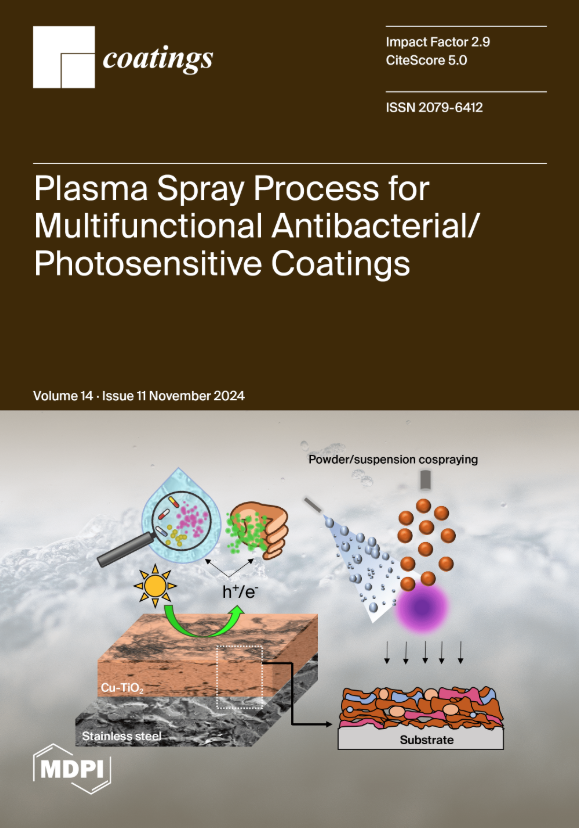利用涂覆在织物基底上的沸石负载纳米纤维去除雷马佐红色染料
IF 2.8
3区 材料科学
Q2 MATERIALS SCIENCE, COATINGS & FILMS
引用次数: 0
摘要
纳米纤维膜具有高孔隙率和表面积,因此在去除纺织废水方面具有巨大潜力。然而,纳米纤维膜的染料去除效率较低。因此,本研究旨在通过加入沸石来提高纳米纤维膜的染料去除性能。研究内容包括通过电纺聚乙烯醇(PVA)纳米纤维和沸石来制造复合膜。通过将 PVA/沸石纳米纤维膜置于可熔无纺布界面和编织聚酯织物之间,然后进行热处理,增强了机械强度。形态分析表明,沸石颗粒均匀地分散在 PVA 纳米纤维中。EDX 分析证实沸石成功地融入了纤维中。在所有膜样品中,PZ-0.75 膜的纯水通量(PWF)最高,蒸馏水的纯水通量约为 1358.57 L-m-2-min-1,蜡染废水的纯水通量约为 499.85 L-m-2-min-1。蜡染废水的浊度随沸石浓度的增加而成正比增加,PZ-0.75、PZ-0.5、PZ-0.25 和 PVA 膜的去除率分别为 84.79%、78.8%、76.96% 和 74.19%。此外,紫外/可见分光光度计显示,随着沸石浓度从 0% 增加到 0.75%,染料去除率从 2.22% 增加到 8.89%。此外,PZ-0.75 膜能有效去除浓度为 1 mg/L 的 RR 染料,最佳接触时间约为 60 分钟。PZ-0.75 膜的吸附机制与 Freundlich 模型一致,R2 值为 0.983。总之,这项研究证明了织物基材中的沸石可以有效改善废水处理的过滤和吸附性能,特别是在纺织行业。本文章由计算机程序翻译,如有差异,请以英文原文为准。
Removal of Remazol Red Dyes Using Zeolites-Loaded Nanofibre Coated on Fabric Substrates
Nanofibre-based membranes have shown great potential for removing textile wastewater due to their high porosity and surface area. However, nanofibre membranes exhibit lower dye removal efficiency. Hence, this study aims to improve the dye removal performance of nanofibre membranes by incorporating zeolites. The research involved fabricating composite membranes by electrospinning polyvinyl alcohol (PVA) nanofibres incorporated with zeolites. Mechanical strength was enhanced by placing the PVA/zeolite nanofibre membrane between fusible nonwoven interfacing and woven polyester fabric, followed by heat treatment. Morphological analysis revealed the uniform dispersion of zeolite particles within the PVA nanofibres. EDX analysis confirmed the successful incorporation of zeolites into the fibres. Among all membrane samples, the PZ-0.75 membrane exhibited the highest pure water flux (PWF) with approximately 1358.57 L·m−2·min−1 for distilled water and 499.85 L·m−2·min−1 for batik wastewater. Turbidity of batik wastewater increased proportionally with zeolite concentration, with removal rates of 84.79%, 78.8%, 76.96%, and 74.19% for PZ-0.75, PZ-0.5, PZ-0.25, and PVA membranes, respectively. Furthermore, the UV/Vis spectrophotometer demonstrated that dye removal efficiency increased from 2.22% to 8.89% as the zeolite concentration increased from 0% to 0.75%. In addition, the PZ-0.75 membrane effectively removed RR dye at a concentration of 1 mg/L, with an optimal contact time of approximately 60 min. The adsorption mechanism of the PZ-0.75 membrane aligns with the Freundlich model, with an R2 value of 0.983. Overall, this study demonstrates the efficiency of zeolite in the fabric substrates to improve the filtration and adsorption properties for wastewater treatment, particularly in textile industries.
求助全文
通过发布文献求助,成功后即可免费获取论文全文。
去求助
来源期刊

Coatings
Materials Science-Surfaces, Coatings and Films
CiteScore
5.00
自引率
11.80%
发文量
1657
审稿时长
1.4 months
期刊介绍:
Coatings is an international, peer-reviewed open access journal of coatings and surface engineering. It publishes reviews, research articles, communications and technical notes. Our aim is to encourage scientists to publish their experimental and theoretical results in as much detail as possible. There is no restriction on the length of the papers. Full experimental and/or methodical details must be provided. There are, in addition, unique features of this journal:
* manuscripts regarding research proposals and research ideas will be particularly welcomed
* electronic files or software regarding the full details of the calculation and experimental procedure - if unable to be published in a normal way - can be deposited as supplementary material
 求助内容:
求助内容: 应助结果提醒方式:
应助结果提醒方式:


